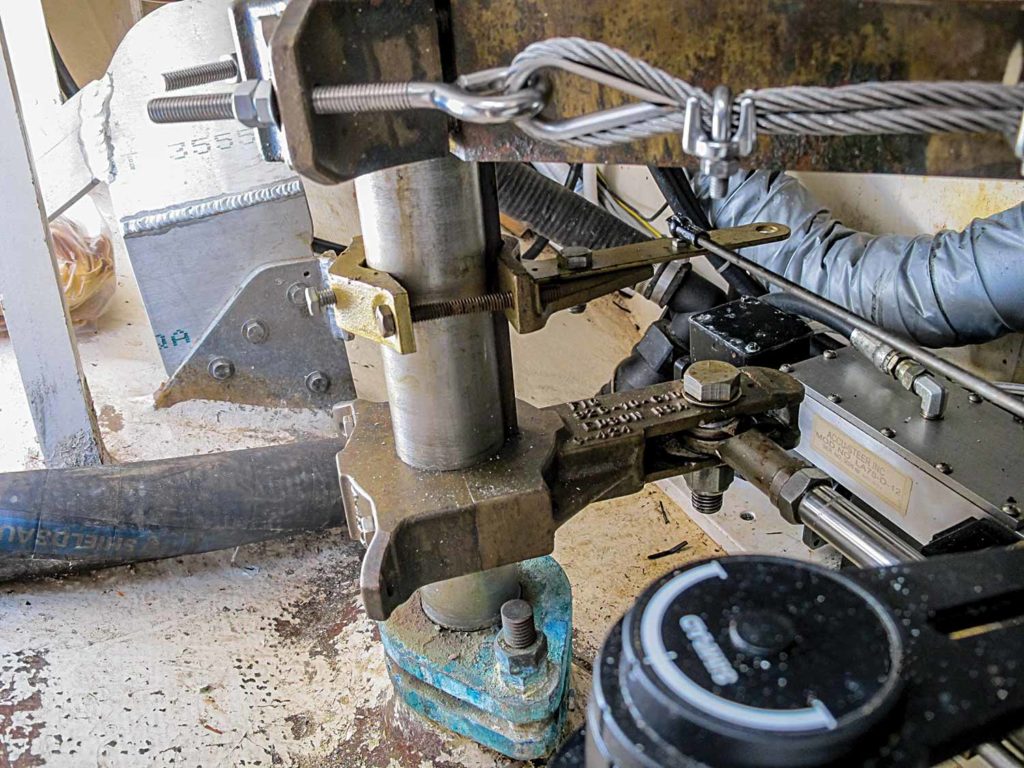
Hand steering is one of sailing’s greatest joys, but the truth is that most sailors struggle to hold an accurate course for more than 30 minutes. This is why racing crews regularly rotate drivers, and why most cruising sailors carry an autopilot that can handle helm duties when the weather turns bleak, attention deficits lurk or other onboard responsibilities take priority over chasing the compass card.
While autopilots have been steering recreational sailboats since Derek Fawcett introduced his original Autohelm in 1974, contemporary systems use solid-state components, cutting-edge processors and powerful algorithms to deliver significantly better performance and advanced features to aid in getting from Point A to B. Here’s a look at what’s on the market and the important things to consider when shopping for a new electronic hand on the helm.
At their core, autopilots consist of four basic components: a black-box central processing unit (CPU), which is the system’s brains and power supply; a hydraulic or electric drive unit that delivers the brawn that physically turns the boat’s rudder; a control head, which the helmsman uses to set a course with the touch of a button; and a heading sensor, commonly a fluxgate compass. Additional bells and whistles, such as a rudder-indicator sensor, a wind-and-speed sensor, and GPS and chart plotter can also be tied into the pilot system via an NMEA 0183 or NMEA 2000 network, allowing the autopilot to access the boat’s navigation system for increased functionality (more on that later).
In its simplest application, once the autopilot’s installed, a skipper manually steers the boat onto a desired course and engages the autopilot using the control head, which is typically mounted near the helm station. Course adjustments are typically made in increments of 1 and 10 degrees, either via hard-key buttons on the control head, a handheld remote control or an app.
When engaged, the autopilot relies on external sensors and internal algorithms to apply the least amount of rudder movement to maintain course. No matter who’s driving, excessive rudder movement directly equates to drag. While autopilots don’t fatigue in big waves the way a sailor might, they do consume more juice when they’re working hard, so autopilot manufacturers develop software controls to properly hold course without sapping boat speed or draining the batteries.
One of the most critical decisions when choosing an autopilot is ensuring that the drive unit is properly sized for the boat. “It’s all based on the boat’s displacement,” says Jim McGowan, Raymarine’s Americas’ marketing manager. When selecting a drive, he advises, “You want to use the boat’s dry weight and then add 20 percent to account for fuel, people and their gear.”
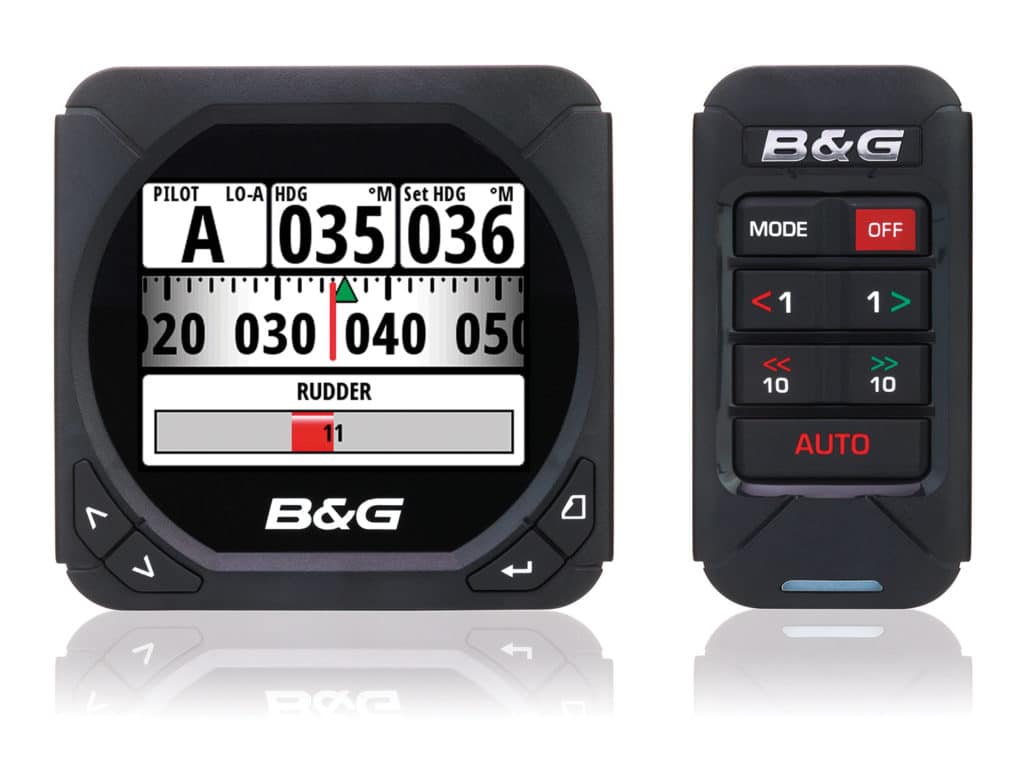
Autopilot drives are typically designed to work up to a certain weight, and it’s important to both performance and safety that this is properly matched as this in turn will dictate the system’s power requirements. Most sailboat-friendly autopilots draw between 2 and 7.5 amps, depending on the size of the CPU required by the system. While the CPUs in a given model range will typically employ identical algorithms, the bigger CPUs deliver more power to their drives.
When buying an autopilot system, be sure your vessel falls well within the designed working range. “When you fall on the line, you always want to go up,” advises McGowan. “It requires a lot of torque to drive the rudder arm in big seas, and if the pilot is up against its limit, there’s a lot more stress on the equipment and more heat buildup in the control unit.”
Matt Fries, B&G’s business acquisition manager, advises that customers should also take into account the design and sailing characteristics of their boat when selecting a drive. “A 40-footer with a full keel and an aft-hung barn-door rudder might require a more powerful drive than a 50-footer of the same displacement that has a more balanced rig/keel configuration and a more modern rudder design,” he says. “It’s more important that the drive suits the boat than who makes it. If [a boat’s] existing drive works and is proven, we’re fine using it.” This same drive-system agnosticism exists amongst most manufacturers and potentially opens the door to cost-effective modular autopilot upgrades, as most modern autopilots can be matched up to power and control different drive types.
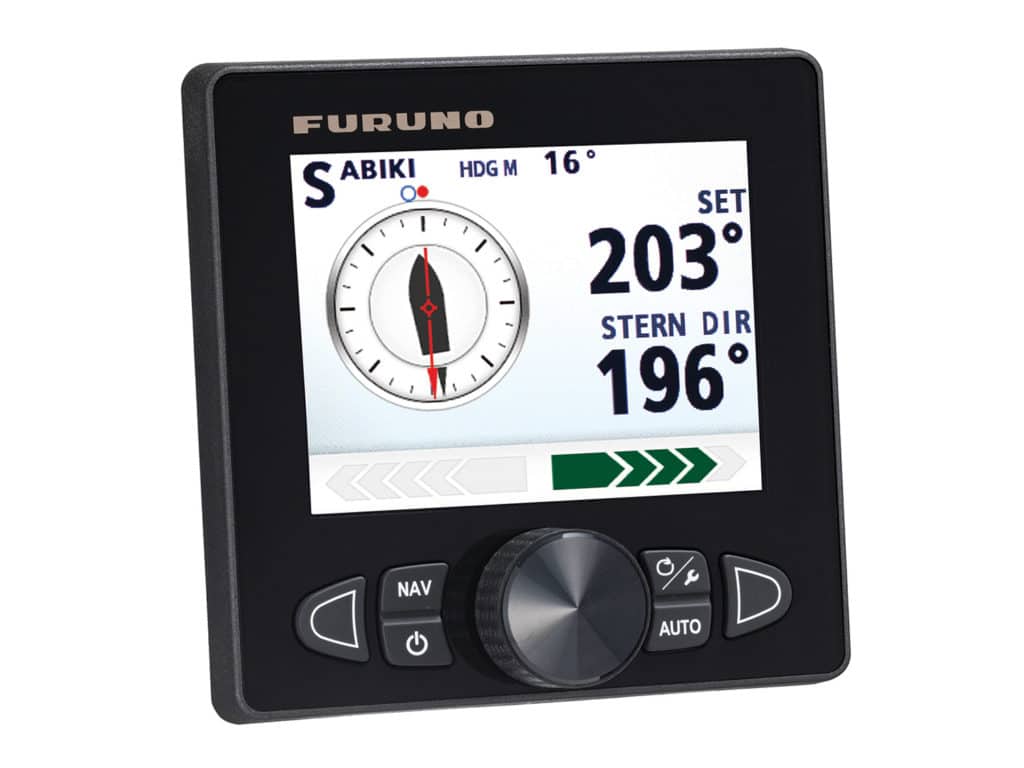
As with all electromechanical systems, the course that the autopilot steers is only as accurate as the input of its sensors — in this case, the most critical data is the vessel’s compass course. While fluxgate compasses provide accurate azimuth information, their reporting rates of 1-10 hertz are sluggish to report course changes compared to today’s nine-axis compasses, which feature updated rates in the ballpark of 10-30 hertz, or that number of times per second. Moreover, the new breed of compasses are accurate to roughly plus or minus 2 degrees magnetic, and also deliver pitch, roll and yaw information, and in some systems, even heel angle. All this data means the autopilot’s CPU and algorithms can more efficiently stay on course. When networked with other onboard devices, the data can also account for vessel motion and the affect it has on wind angle and speed data. As a result, nine-axis compasses have largely usurped fluxgate compasses.
“The EV1 is the system’s decision maker,” says McGowan, describing the role of the solid-state attitude heading reference system (AHRS) that’s central to Raymarine’s Evolution autopilot system. “All smarts are in there, and it sends its command signals to the control head and the drive.” The system is upgradeable, allowing Raymarine to push new features out to existing Evolution autopilots.
While nine-axis compasses have become the industry standard for autopilot heading sensors, even more precise options exist. “Furuno pilots interface really nicely with our SC33 satellite compass,” says Eric Kunz, Furuno’s senior product manager. And, he notes, the cost for these sophisticated compasses has been dropping. “It delivers roll, pitch and heave information, and it’s accurate to .5 degrees, which allows the system to steer a straighter course.”
As previously mentioned, modern autopilots are typically NMEA 0183 or NMEA 2000 compatible, allowing their information to be displayed and sometimes controlled via the vessel’s chart plotter. “One thing that’s changed dramatically is that you used to need a dedicated control head, but now plotters can control this,” says McGowan. In other words, Raymarine chart plotters can control the company’s Evolution autopilots. While this capability exists across all brands, not everyone is sold on chart-plotter control alone.
“I wouldn’t go to sea with just a chart plotter controlling the autopilot,” says Kunz, citing safety risks. “With our NAVpilot-711C, you need a connection between the processor and the control head and the heading sensor.” Up to six control heads can be added to the system.
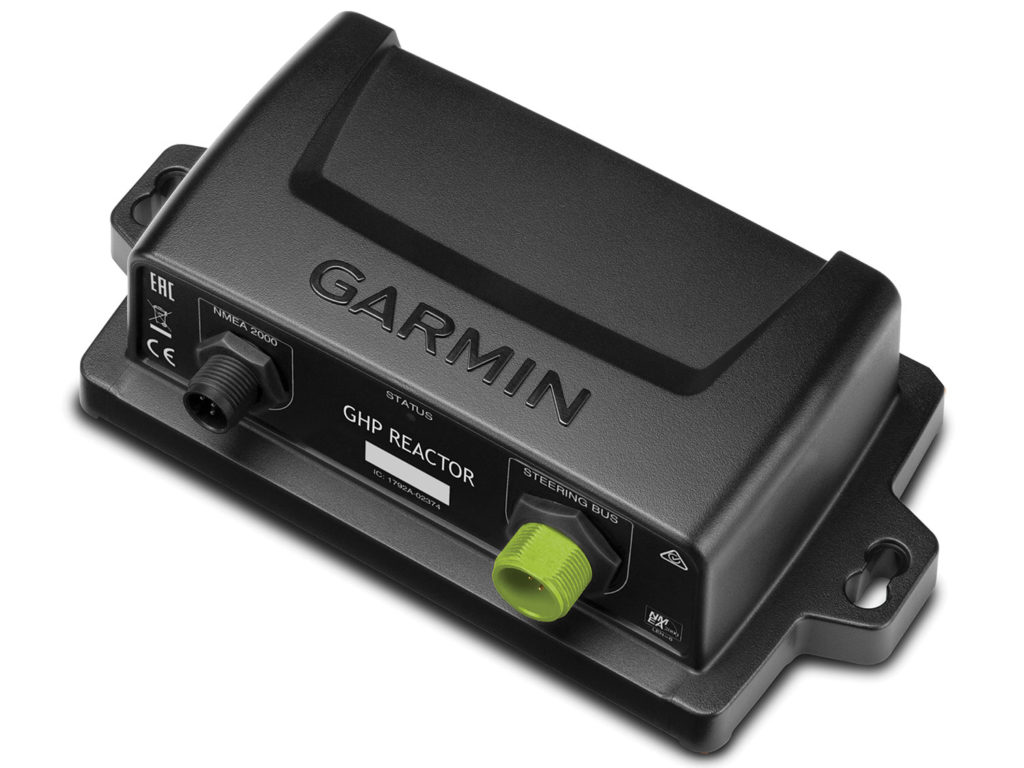
Irrespective of what interface a boat owner employs, today’s autopilot systems offer new capabilities and sailing-specific features. Perhaps most publicized is their ability to auto-calibrate and adapt to a vessels particular motion underway.
“Before our Evolution autopilots, it took a lot of work to get a [Raymarine] autopilot set up and calibrated,” says McGowan. “You had to spin circles so that the autopilot could figure out the boat’s magnetic deviation.” By contrast, Evolution pilots automatically “learn” the boat’s turning characteristics over time. They work right out of the box, and their AHRS sensors are so sensitive that they can calculate what’s happening on the boat in real time.
While this is great for anyone who hates owner’s manuals, not all experts are ready to trust in technology alone.
“All autopilots should be properly commissioned and sea-trialed to ensure proper steering performance before being put into service,” says Fries. While B&G’s pilots support auto-calibrating and self-learning capabilities, there’s useful information that’s best gleaned the old-fashioned way. “After swinging the compass, the system gives you a field percent score, which shows the ratio of the boat’s local magnetic field to the earth’s magnetic field. I like to see less than 15 percent.” (See “Smartphone Detection,” below)
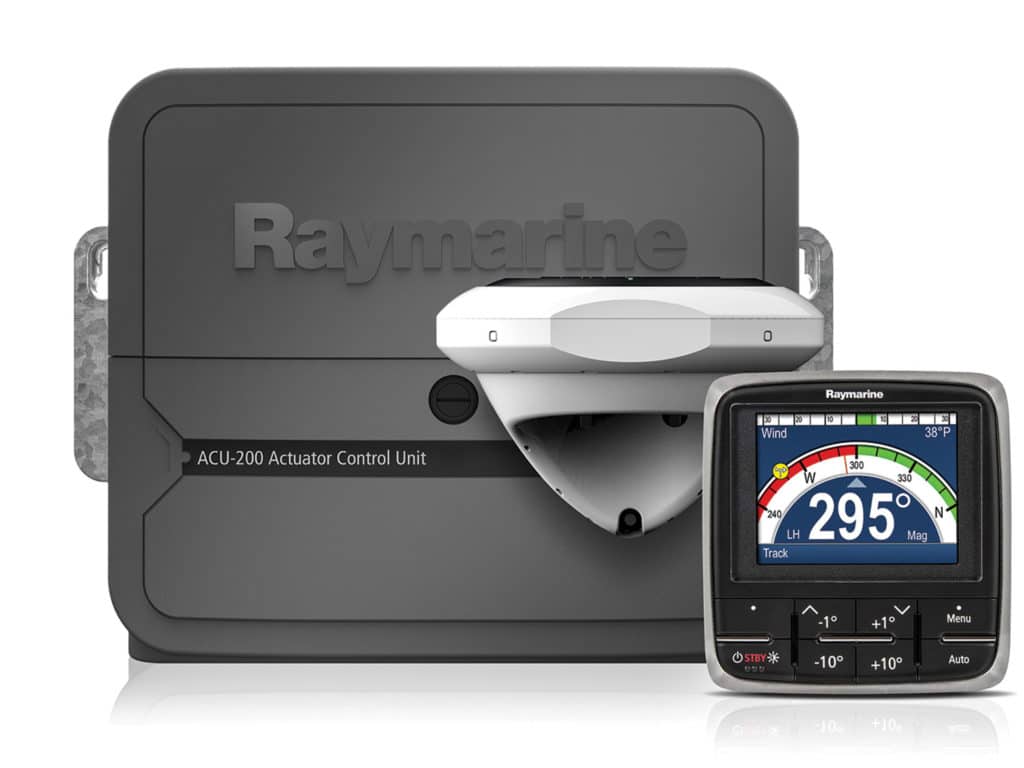
Once set up and calibration is complete, users can dial in the amount of acceptable cross-track error when underway. Furuno, for example, offers two different driving modes: economy and precision. “With precision mode, we’re trying to keep the boat right on the cross-track line,” says Kunz. The system essentially sets a waypoint 100 miles out and maintains a course that’s within a 6- to 10-foot accuracy zone. In economy mode, the system lets the vessel’s course drift more, so there’s less rudder movement and drag. Kunz says this is especially beneficial to bluewater sailors.
Another interesting feature involves using the vessel’s cartography and chart plotter capabilities to automatically generate a route, which is sent to the autopilot as a series of waypoints. “If you’re using a Garmin chart plotter, running Garmin’s g3 cartography and using a Garmin autopilot, the system will follow a route that was generated by auto-routing,” says Dave Dunn, Garmin’s director of sales and marketing for marine. Furuno also offers similar capabilities thanks to its ownership stake in TimeZero (née Nobeltec and MaxSea). “TimeZero can take in the boat’s polars and take into account wind [forecasts] and the best time to go,” says Kunz. Skippers using computers that run the necessary Windows-compatible software can access this same functionality using a USB gateway that connects to the autopilot’s processor.
While NMEA 0183 and NMEA 2000 compatibility between the autopilot CPU and a chart plotter or computer has in some cases eliminated the need for a dedicated control head, it has also opened the door for app-based remote control. Contemporary chart plotters are all Wi-Fi enabled and most manufacturers, including Garmin and Furuno, build smart-device apps that deliver wireless plotter control, and therefore autopilot control. For the record, B&G and Raymarine do not allow this functionality for safety reasons.
In addition, Garmin allows users to control their autopilots via a quatix 5 watch and the company’s new Reactor Autopilot Remote controller, which features gesture control (see “Mind Control,” left). “You just point it to a heading, and the boat will sail the course,” says Dunn. As of now, Garmin is the only manufacturer to offer a gesture-sensitive control for a sailboat-compatible system, however Furuno makes a similar remote control for its powerboat-specific NAVpilot 300.
Recent years have also seen the advent of newer sailing-specific software features such as B&G’s ability to steer to specific wind angles. “If you engage the pilot’s wind mode, it will steer apparent wind angles, and downwind it will steer true wind angles,” says Fries. “The idea is that it’s easy to sail to the telltales upwind, but when you’re sailing downwind in seas, true wind angle is more stable and can avoid a crash gybe.”
McGowan says Raymarine has updated the Evolution’s ability to steer a course using a windvane as well, and it has also improved the system’s ability to perform automatic tacks when sailing to weather without overstanding its new course.
Finally, modern autopilots usually offer some sort of man-overboard mode, be it prescripted driving patterns or the ability to hold the bow in irons.
NKE takes this a step further with its system-agnostic Crew Transmitter, which establishes an electronic link with your nav system that’s broken if a user-worn pendant travels more than a certain distance away. Should this happen, the nav system drops a pin and triggers onboard MOB alarms. Using NKE’s Gyropilot remote control system, if an NKE autopilot is engaged at the time of the crew-overboard incident, it will either turn the boat into the wind or, if there’s no networked wind sensor, put the helm hard over.
Given the increased functionality, features and performance of modern autopilots, there’s little reason to suffer long stints at the wheel unless, of course, you feel like steering just for the fun of it.
David Schmidt is CW_’s electronics editor_.
Autopilot Manufacturers
- B&G: 603-324-2042; from $2,300.
- Furuno: 360-834-9300, from $3,400.
- Garmin: 800-800-1020, from $2,000.
- NKE Marine Electronics: from $5,400.
- Raymarine: 603-324-7900, from $2,000.
Smartphone Detection
Magnetic interference is a time-honored autopilot headache and can be triggered when equipment is loaded aboard or new systems are added. While properly installed, self-learning autopilots will eventually detect — and correct for — this interference, a smarter and more immediate tip, says B&G’s Matt Fries, involves using an app. “Everyone has a smartphone, and there are [deviation-sensing] apps that measure the boat’s magnetic field,” says Fries. “An owner might not realize that there’s an [outboard] motor behind a bulkhead.”
If there’s a magnetic-interference issue at play, this trick, coupled with the field-angle percentage that’s generated when swinging the boat and autopilot compass, should reveal the culprit.
Mind Control
An 8- to 10-knot southerly blew across Seattle’s Portage Bay as John Tenneson, owner of the nicely appointed J/145 Jedi, handed me Garmin’s new gesture-enabled Reactor Autopilot Remote controller, which was wirelessly tethered to Jedi’s Garmin autopilot. I aimed the controller 10 or 15 degrees off the port bow, pressed a button and Jedi immediately responded. Next, I made a slower turn to starboard, followed by a few dozen more maneuvers, executed simply by gesturing and pressing.
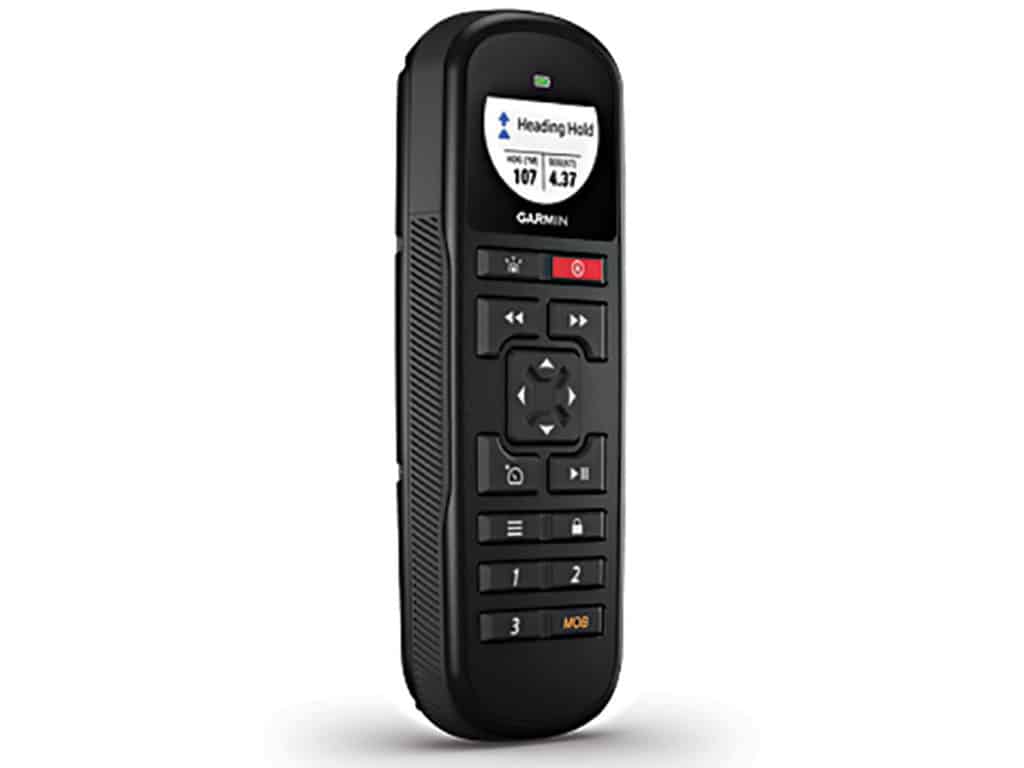
The remote also handles industry standard 1- and 10-degree course correcting commands and features three user-programmable hot keys, a dedicated MOB button and the ability to initiate auto tacks, based on apparent wind angles. The auto tack feature is especially helpful for shorthanded upwind work.








